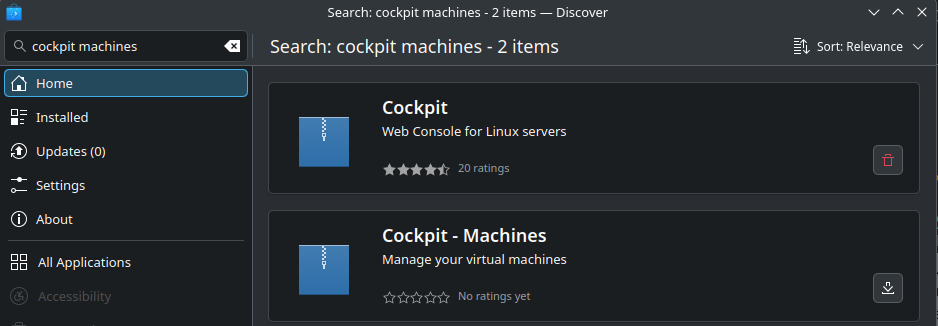Not really sure how dualbooting or vms work at their core. I’m kind of over windows and want to swap, always liked the customizability aspect and have been using Linux more and more for self hosting purposes. Was wondering if I setup linux on my external ssd using a vm if I could change it from vm to a dualboot drive after I’m done setting it up. That way I could setitup and swap to it while keepign my original ssd with my windows install,. and not have to deal with dualbooting and going back and forth while setting up?
Can I make a vm of my current windows machine backup and run that in a linux setup?
You can, but it’s a bit difficult.
My suggestion would be to use a LiveCD. Test it out and see if like whichever distro you choose. It completely replicates the feeling of *nix being on your hardware without any commitment.
There’s not really a simple way to make a VM setup permanent. You could try it out in a VM, and then use a backup tool to save your home directory and system configuration to transfer your settings to a “real” hard drive installation.
My recommendation would be to use clonezilla or a similar tool to make an image of your windows install and save that on the external ssd.
Then I would install Fedora KDE or whatever’s your poison on the internal drive.
If you wanna switch back to windows then you can always use clonezilla, or your tool of choice, to restore the image.
You could also use KVM/Qemu in your linux distro to restore the image into a windows vm.
virt-manager gives you a desktop gui while cockpit + cockpit-machines gives you a nice webui for handling virtual machines in linux.Clonezilla guide, for both linux and windows
https://www.linuxbabe.com/backup/how-to-use-clonezilla-liveBoth Cockpit and Virt-Manager are available in Fedora KDE’s Discover app if you prefer GUI installs:
Cockpit

Virt-Manager

This is good advice imo. Some further comments:
- Its easier to make a vm out of a bare metal or “real” install. It’s much harder to go the other way.
- you seem to have some fear about installing or reinstalling OSs. It’s much easier than redeploying vms. I’d banish those thoughts and jump in. Again the above advice is solid because you can mess up or change your mind, and you can always revert. Cloning a drive and redeploying that image to the original drive is simple.
- dual booting gets a lot of flak. Most of that comes from windows not playing nice with boot partitions when windows is installed on the same drive. Another source of issues is secure boot. If you have two internal drives, installing an os on each one works great. I like turning secure boot off and simply pressing F8 upon boot up if I want to switch. (But you totally can get it working with secure boot and adding other OSs to grub.
+1 for both comments above.
Back up your current disk! If you do it properly you can always restore your current operating system if this experiment doesn’t pan out.
Fedora KDE is an excellent starter choice. The DE will feel relatively familiar coming from Windows and Fedora is very much a batteries included distro. Red Hat guides are excellent and very useful in that family.
I’ll look into this, thank you!
That would definitely be a technical challenge, but also it’s absolutely possible.
I used to do dual-boot Windows + Linux and I could run the Linux installation from a VM in Windows as well as the Windows installation from a VM in Linux.
When rebooting between metal and VM, Windows would always spend a few minutes “doing things” before continuing to boot, but it worked.
Linux would not even fret. It would just boot normally without any complaints.
I don’t remember exactly which distro I had at the time, but probably it was Linux Mint.
Interesting. Does modern Windows allow booting OEM version into VM? Historically it was a) not allowed by license, b) not possible because Windows tended to hard configure to your motherboard hardware for example. Back in the Windows 7 days, I had to buy a separate Windows 7 Pro version to move from dual booting windows to running windows in a VM and dumping the annoying dual boot config. Back then the Consumer and OEM versions were not allowed to run in VMs. Non-OEM Pro and Enterprise were.
Also, I agree. Linux generally can boot into changing environments without issue. Windows, always a question.
Iirc I had a Windows 7 (maybe 8 or 10) Home OEM, original (not cracked), but it still worked. Perhaps if I had kept using it for long periods in the VM it would have started complaining? Anyways I booted it baremetal from time to time, so maybe that’s why it kept working.
yup, I did the “linux running metal” and using the same partition with a VM in Windows and it worked fine. It was years ago, certainly Ubuntu or MX Linux. IIRC the linux partition cannot be on the same drive than the linux partition, it needs to be a different drive.
Maybe. If you can create the partition and set your hypervisor to use it as the virtual disk, then yes. But it might actually require a whole drive to do that. I can’t promise that it would easily convert from one to the other though. I would just go right for the dual-boot and use it as much as you can.
no dual boot. just jump in, the water is fine.
I’ve switched to using it as my daily driver, and depending on what applications you use, the water is either fine, or is full of piranhas.
Using VR, for example, is still a massive pain in the ass, and requires me to boot into windows when the tenuous stack of software driving it on linux decides to stop working because it’s a full moon out.
Touch anything the wrong way, and you’re digging through random config or build files to fix it.
VR nevee worked for me the way it should like on Windows.
It did work many times and was playable. But soft stuttering was there. People literally gaslighted me on the internet that there is no stuttering while there obviously is
Stuttering is present in SteamVR due to lack of async reprojection. Thats why I’m using Envision which is an interface for a stack of a bunch of different open source VR stuff.
It’s quite a bit more finicky and fragile, but it at least has reprojection.
Is there an easy Guide? Would love to play around with it on Arch Linux with Wayland KDE
https://lvra.gitlab.io/ is a good start.
Some stuff you’ll have to mess around with.
I’ve found that some random issues like unexpected frame stutter or VR headset not being detected need a full power off of everything to fix sometimes. (Power off / disconnected. Reboots don’t work)
Today I tried it. It was pretty easy because of AUR on Arch Linux.
I tried Ancient Dungeon VR and it worked pretty well. I just need to figure out how to use some plugins like Stardust or smth. I slammed my Table because I couldn’t see the borders.
But I can say one thing. You helped me mentally a lot. I don’t need to play most games anymore in Windows I assume. Windows literally killed all my plans for the day everytime I wanted to “play quick” and “work quick”. There was just one thing to do, and I mostly procastinated because I wasn’t sure if I should reboot or not. BUT NOW I CAN JUST PLAY WHENEVER I WANT AND STOP WHENEVER I WANT. FUCK YEAH! Thanks a lot!
Awesome! Glad you were able to get everything working! It’ll probably still be frustrating somtimes, but I hope you enjoy it!
Piracy seems harder, like whats the alternative to vfxmed for stuff like houdinifx
Houdini FX has a Linux version, you’d just have to find a copy of it for Linux.
Correct, but I believe the user is looking for a cracked version, as they don’t have a license. The likelihood of that existing is significantly lower on Linux than it is for Windows given the much smaller userbase, the fragmentation into multiple package formats, and the overall distaste of proprietary software in the Linux community.
I found 20.0 on the first page of DDG but go off…
I can’t help with pirating software, your options are going to be heavily limited because most people running Linux would just prefer open source alternatives (like Blender), so it’s far less likely you will find cracked software specifically made for Linux (plus, there is a far smaller userbase). On some quick searching, I did find someone who had issues running Houdini in a VM (for multiple distros), but it worked fine when it was installed natively. I’m not seeing an entry in the WINE database for Houdini, so while you could always try running a Windows version through WINE, given the type of program it is, I highly doubt it would run without issue. I have no recommendations on how to get ahold of a Linux compatible version without a license.
Yeah, itd be fine as long as the simulation part works, I’ve heard blender gets 30% better performance and its what I use for 50% of my process and is part of why i want to switch. I had forgotten about wine.
What is that
Hollywood vfx, 3d procedural modeling software (also used for setting up game environments and a ton of other stuff), I enjoy using it, might someday buy it, but its only a hobby I make no money off so I pirate it
Yeah I’d definitely dual booting while you wet your toes if you want to go full linux, then run a windows vm of you cant find anyway to replace that.
I run a windows vm on my server for my 360 tour and editing stuff but everything else is on my main linux machine now
Used to play videogames now I spend days making reusable vfx that I never end up using, need to buy some interesting mocaps because I dont like hand animating ive come to find
off topic, but I saw you mentioned vr on other post so wondering wether you considered setting up vr mocap? For casual hobbyist like me stuff like glycon3d in enticing though I don’t know what type of mocap you’re after.
I just don’t enjoy the animation part that much, I like combining existing mocaps and then adding vfx, where I spend 75% of my time.
Probably possible but highly technical. Might be better to just run Windows or Linux in a VM whichever system you won’t use much. Exception is gaming or other apps that need hardware video acceleration. I aleays found dual booting annoying unless you have to do it, though I did use it 25 years go when started with linux.
Be aware. you may have to buy a specific Windows version to run it in a VM. OEM versions historically were not licensed for VM use. Also changing hardware configs for Windows historically has been a nightmare without clean install.
If you go with NixOS or guix, both of which are declaratively configured, you can swap 99.9% seamlessly. I run the same NixOS config on 2 machine and a VM. Only thing I had to modify between them are some driver specific settings, but those are easy to isolate.
NixOS and Guix are both very beginner-unfriendly. If you’re not very comfortable with Linux and its command line, I’d recommend against using them for personal systems.
It wouldn’t be seamless but if you used an “immutable distro” like Fedora Silverblue then 95% of your customization would be in your home directory. You could go from VM to bare metal and then copy over all of your home files.
You can go ntfs -> qcow and put your windows in a vm. It sucks more to go qcow -> ext3 and put your Linux vm on a metal.
Just dual boot. It’s easy and it works and you have a little computer in your pocket to look shit up on if you’re scared about fucking anything up.
Before you dual boot: turn off fast startup in windows, turn off uhh bitlocker(?) and make sure your bios will let you.
Make a backup first, because you don’t have one now and if anything happens you’ll lose everything. Nothing will happen, nothing ever happens, but knowing you’re not fucked makes you feel more confident.
E: people will tell you to use a different ssd or whatever for Linux. That’s stupid and bad advice. Don’t do it. Just clear off some space on your boot device and use it.
E2: fixed a typo.
long ago redhat had a way of outputing a kickstart file to use to instal on other machines and suse had something similar. no idea what they use for that now though.
Here’s a post explaining how dual booting works.
When you turn on your computer, the bios or bios equavalent goes down its list of devices to try and boot from. It might have usb or cd first and ssd next, so if you put a cd or usb it’ll boot that automatically.
Devices that can be booted have special instructions in the first part of their storage that can be used to operate the hardware.
When the bios finds a device that can be booted it hands the hardware off to that device and breathes a sigh of relief, most of its work is over. That devices work is just beginning though.
If it finds a windows disk, that disks bootloader will load a minimal set of hardware drivers necessary to load the rest of windows and it builds itself up towards having a functional running windows operating system and presents a login screen to the user.
If it finds a Linux disk, the disks bootloader will do the same thing but instead of loading a set of drivers, kernel and configuration that let it start a windows system it will build towards having a running Linux system. Duh.
When you dual boot, the device the bios finds to boot from doesn’t do either of those things, it runs a bootloader that presents you the user with a choice between the two, then hands the task off to one or the other based on your choice.
Setting up dual booting means clearing off space and shrinking the windows partition so you can have a Linux partition, installing Linux to it and then installing a bootloader that gives you the option to use either os.
Great explanation, is using an external ssd instead of a partition still considered dualbooting?
Yes, but the bios will still need to go to the device with the bootloader on it for you to make the choice.
In the case that the external is unplugged or had a damaged wire or something, it won’t work.
Depending on your circumstances you may be better served by just installing Linux on the external device, not writing grub (the bootloader that lets you choose) to your internal drive and instead just booting from it like a usb.
I don’t generally recommend that to people, but if you absolutely will not use partitions no matter what then it’s a less complex way of accomplishing some tasks.
E: I want to be clear that you are setting yourself up for failure and unhappiness if you try to use a usb device chain booted off grub. You will make your life incredibly complex and make it hard to get help if you try to migrate that setup to your boot device.
It is infinitely easier to move your files to the external and dual boot from partitions on one device like a normal person.
Why do you want to use a vm or boot from your usb drive in the first place?





